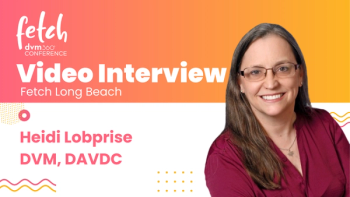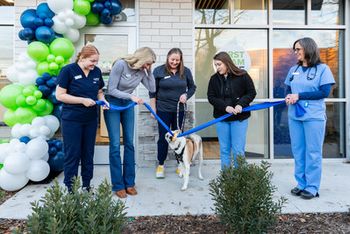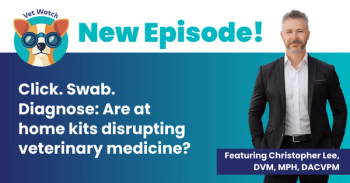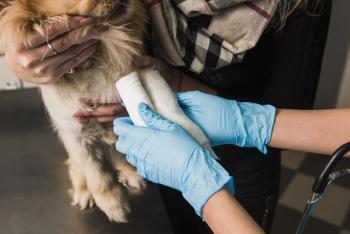
Training new leaders with CPR instructor certification course
The RECOVER Initiative provided a 2-day workshop for veterinary professionals to learn how to teach a CPR certification course during the NAVC SkillShop event.
The RECOVER Initiative presented a 2-day CPR instructor certification course on basic and advanced life support at the
In this video, course leader Kenichiro Yagi, MS, RVT, VTS (ECC) (SAIM), chief nursing officer for Veterinary Emergency Group and RECOVER program director; and Dan Fletcher, DVM, PhD, DACVECC, professor of emergency and critical care at Cornell University College of Veterinary Medicine and co-chair of the RECOVER Initiative, discuss aspects of the course and what NAVC SkillShop attendees were experiencing. Additionally, newly certified RECOVER CPR instructors Jennifer Dow, RVT, VTS (ECC), a North Carolina-based travel nurse for Veterinary Emergency Group; and Anita Parker, RVN, AVN, VTS (Anesthesia & Analgesia), CVPP, employee engagement officer for Veterinary Specialist Services in Brisbane, Australia, talk about how they will bring what they’ve learned from the course back to their respective roles as trainers and educators, in dvm360 interviews.
The following is a transcript of the video:
Dan Fletcher, DVM, PhD, DACVECC: The RECOVER Initiative was launched in 2012. We published evidence-based veterinary CPR guidelines at that time, and we just updated them in 2024 based on the newest evidence available. So this course is really targeted at teaching people how to teach other people how to do CPR according to those evidence-based guidelines. For me, it's a really exciting course because it really allows us to expand our impact. We're going to be training. We train 24 people here during this [NAVC SkillShop] conference. Those 24 people then go out and train a whole bunch of other people themselves, and so we can really multiply this impact.
I think this course is really a unique course in that we have online content that is covering the basics of the guidelines, so they get a didactic introduction to what the guidelines say. And then they can come into this lab, and they can actually practice applying those guidelines to simulated cases.
Kenichiro Yagi, MS, RVT, VTS (ECC) (SAIM): We teach our instructors how to take a more learner-centric approach to teaching. We want to not just give people information but also facilitate a discussion based on what they just experienced in the simulation to draw out the information that they learned before they came into the workshop itself.
Anita Parker, RVN, AVN, VTS (Anesthesia & Analgesia), CVPP: The way the course is structured is really nice. You start off with your little baby steps, and then they get you up to the final outcome. And each step of the way, you're feeling more and more confident each way.
Fletcher: These folks who come in, and they have the knowledge in their heads, they know what they're supposed to do, but when they first try to apply it, it can be a little rough the first few times they try. And then after some training for the day and really practicing applying it. It's just amazing to see where they get. They're remarkably good at implementing these guidelines in real cases after doing that. So it's just really fun to watch where they get during the course of the day. And now all these instructors get to go out and experience that for a whole bunch of people all over the world.
Jennifer Dow, RVT, VTS (ECC): I've been in the field for a very long time, and when I first learned how to do CPR, I didn't wasn't given very much instruction. Everything felt very chaotic. And so I've been practicing the RECOVER CPR for the past 3 years, and I've definitely seen a difference in outcomes, achieving ROSC [return of spontaneous circulation] and even some survival to discharge as well.
Fletcher: So we have some new approaches to how to do chest compressions in dogs and cats. We have some new approaches to how to ventilate dogs and cats. So quite a bit has actually changed, and we're really excited, because that's all based on the evidence that's out there. So we really feel good that we're teaching the best evidence-based approach that we can.
Yagi: By creating a safe environment for them to be able to answer questions and maybe they get the answer wrong, but that's OK, because we're just all here to learn, and being able to facilitate that discussion, allowing them to get to the answers themselves, really is a better way of people learning and thinking about the situation, using their critical thinking skills in order to make it stick, in the end.
Parker: We're in this business because we actually want to take care of our pets, take care of other people's pets, and if we are being trained in the proper aspect, then we should be able to go home feeling that we've done everything correctly in the first instance. Because, let's be honest, we have a really tough job, and we are our own worst critics. So the moment we can keep practicing on these skills, the less we're going to totally eliminate it, but we're less likely to feel that we haven't done a good job if we've been provided the correct training on a regular basis. So we go into both scenarios, really, really confident.
Dow: You should definitely take this course if you are in the veterinary field, really any type of veterinary field, just because you never know when an emergency can happen.
Newsletter
From exam room tips to practice management insights, get trusted veterinary news delivered straight to your inbox—subscribe to dvm360.






